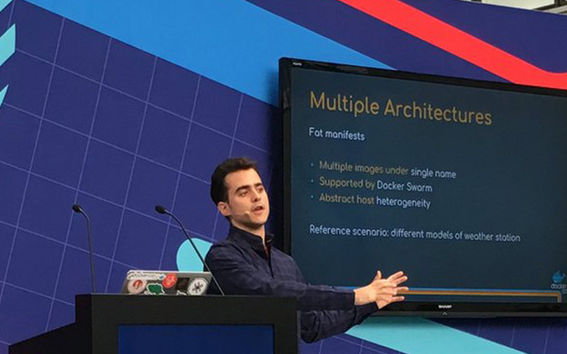Master’s student Daniel Bruzual successfully combined software containers with Internet of Things

Master’s student Daniel Bruzual was selected as one of the speakers of the Docker conference in October. The topic of Bruzual’s Docker presentation was deploying software containers on heterogeneous Internet of Things devices. His contribution was applying and extending the Docker framework for this scenario.
The Internet of Things is characterized by millions of embedded devices, producing vast amounts of data that needs to be processed. These devices are highly heterogeneous with varying architectures, hardware and software configurations. The data produced by these devices is typically sent to powerful servers in the cloud, where it is processed and stored. By enabling devices to communicate it is possible to use the combined processing power to process that data locally instead. This leads to savings in data transfer, more security and faster processing.
“If you take a smart farm as an example, there are automated irrigation and fertilizing machines, weather stations and drones flying over the plantations and taking pictures. These devices communicate and jointly process the data. Drones send pictures to the weather stations for processing and analyzing, whereby the weather stations identify areas, which need more nutrients or water and notify the sprinklers. The tools I applied and developed make it possible to deploy this type of distributed application, simplifying the installation of new applications, adding new devices and also remotely managing the devices”, pictures Daniel Bruzual.
Software containers enable distributed applications and remote management
Docker is a suite of open-source tools and technologies, which allow packaging and running applications inside software containers. Software containers are like small pre-configured boxes containing programs and instructions, ready to run an application in a pre-programmed manner. They simplify the development and deployment of complex applications by breaking them down into small components that can be easily installed and replicated, without having to pre-configure the servers where they are executed.
Containers allow deploying the same programs on the devices, without having to worry about the differences in hardware or software on the device. They also simplify the process of updating device software remotely, and even enable multiple devices to communicate. These technologies are widely popular in the cloud, used by companies such as Amazon, Google and Microsoft to make their applications scalable to millions of users. However, the same principles can also be applied on the Internet of Things.
“Imagine that you have tens, hundreds or thousands of devices that you want to manage and run applications on. It is hard to do it manually, checking if any of the devices failed, connecting to each one separately and running commands there. The set of tools I have applied and developed simplify the entire process, from the initial set-up of a new device to remote management of connected devices. You can tell the framework to run a certain number of copies of a container, and it ships that container to any of your devices and runs it there. Containers running on different devices can also exchange data through a simple interface, thus, enabling distributed applications”, explains Bruzual.
Bruzual comes from Venezuela and is currently finalizing his thesis in Professor Mario Di Francesco's group at Aalto University. He is enrolled in the Master’s Programme in ICT Innovation, which is part of the double degree cooperation of EIT Digital Master School. Bruzual’s major is Service Design and Engineering and a minor in Innovation and Entrepreneurship. He arrived in Finland in 2016, having spent first year of his Master’s studies in Trento, Italy.
“I came here because I had pictured a very organized society with an efficient way of carrying out projects and business. I wanted to experience that for myself and learn how to be more efficient in work and management tasks. Studying at Aalto has opened up many opportunities”, concludes Bruzual.
More information:
Daniel Bruzual
[email protected]
Twitter: @danbruzual
Mario di Francesco, Assistant Professor
[email protected]
tel. +358 50 5975 250
Read more news

Get to know us: Associate Professor Maria Sammalkorpi
Sammalkorpi received her doctorate from Helsinki University of Technology 2004. After her defence, she has worked as a researcher at the Universities of Princeton, Yale and Aalto.
Aalto computer scientists in ICML 2024
Computer scientists in ICML 2024
Getting bacteria into line
Physicists use magnetic fields to manipulate bacterial behaviour